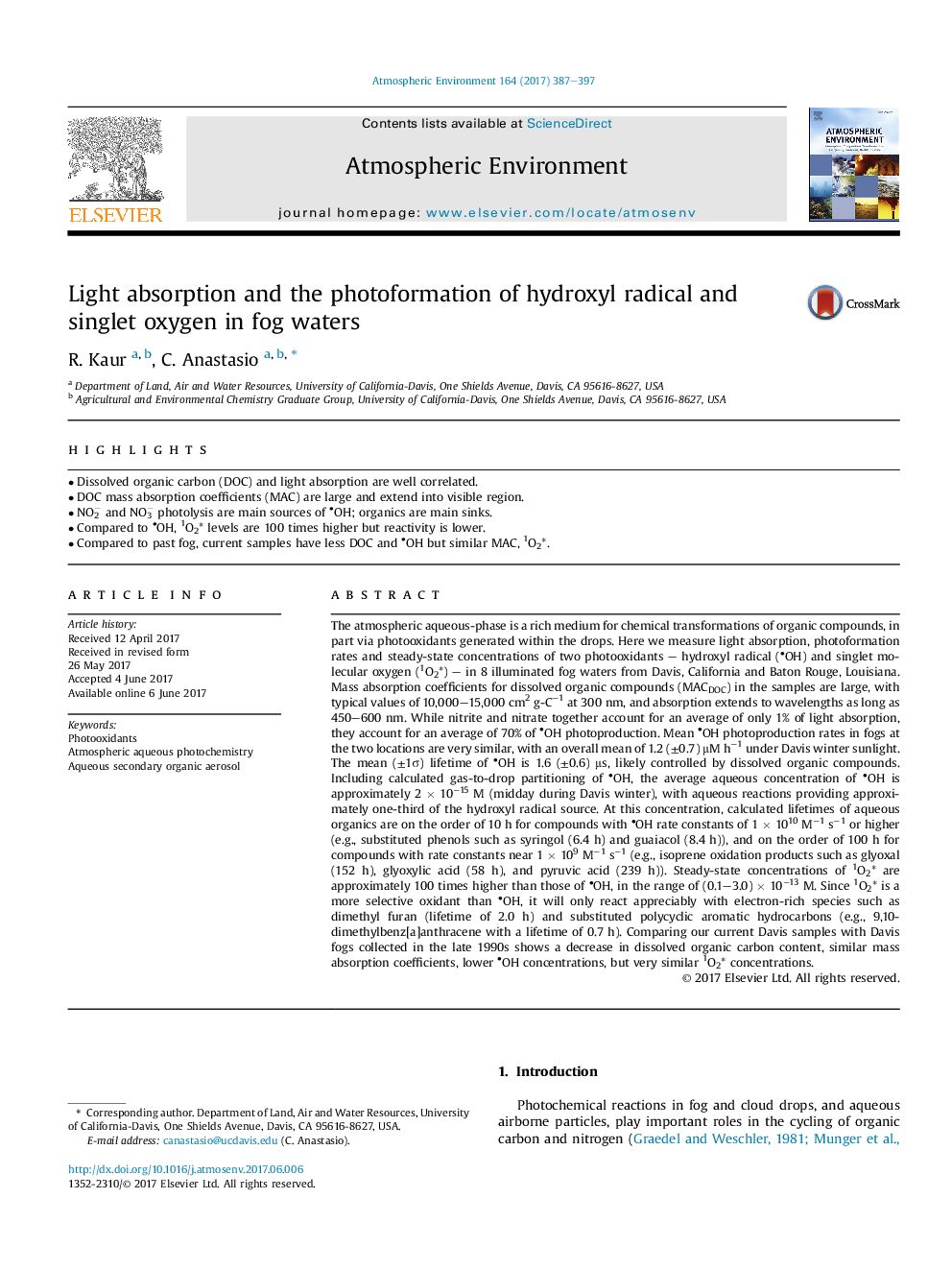| کد مقاله | کد نشریه | سال انتشار | مقاله انگلیسی | نسخه تمام متن |
|---|---|---|---|---|
| 5753138 | 1620310 | 2017 | 11 صفحه PDF | دانلود رایگان |
عنوان انگلیسی مقاله ISI
Light absorption and the photoformation of hydroxyl radical and singlet oxygen in fog waters
ترجمه فارسی عنوان
جذب نور و شکل گیری اکسیداسیون هیدروکسیل رادیکال و یکپارچه در آب های ریز
دانلود مقاله + سفارش ترجمه
دانلود مقاله ISI انگلیسی
رایگان برای ایرانیان
کلمات کلیدی
عکس اکسیدان ها، فتوفیزیک آبهای اتمسفری، آب آبیاری آلی متوسط،
موضوعات مرتبط
مهندسی و علوم پایه
علوم زمین و سیارات
علم هواشناسی
چکیده انگلیسی
The atmospheric aqueous-phase is a rich medium for chemical transformations of organic compounds, in part via photooxidants generated within the drops. Here we measure light absorption, photoformation rates and steady-state concentrations of two photooxidants - hydroxyl radical (
- OH) and singlet molecular oxygen (1O2*) - in 8 illuminated fog waters from Davis, California and Baton Rouge, Louisiana. Mass absorption coefficients for dissolved organic compounds (MACDOC) in the samples are large, with typical values of 10,000-15,000Â cm2 g-Câ1 at 300Â nm, and absorption extends to wavelengths as long as 450-600Â nm. While nitrite and nitrate together account for an average of only 1% of light absorption, they account for an average of 70% of
- OH photoproduction. Mean
- OH photoproduction rates in fogs at the two locations are very similar, with an overall mean of 1.2 (±0.7) μM hâ1 under Davis winter sunlight. The mean (±1Ï) lifetime of
- OH is 1.6 (±0.6) μs, likely controlled by dissolved organic compounds. Including calculated gas-to-drop partitioning of
- OH, the average aqueous concentration of
- OH is approximately 2Â ÃÂ 10â15Â M (midday during Davis winter), with aqueous reactions providing approximately one-third of the hydroxyl radical source. At this concentration, calculated lifetimes of aqueous organics are on the order of 10Â h for compounds with
- OH rate constants of 1Â ÃÂ 1010Â Mâ1Â sâ1 or higher (e.g., substituted phenols such as syringol (6.4Â h) and guaiacol (8.4Â h)), and on the order of 100Â h for compounds with rate constants near 1Â ÃÂ 109Â Mâ1Â sâ1 (e.g., isoprene oxidation products such as glyoxal (152Â h), glyoxylic acid (58Â h), and pyruvic acid (239Â h)). Steady-state concentrations of 1O2* are approximately 100 times higher than those of
- OH, in the range of (0.1-3.0)Â ÃÂ 10â13Â M. Since 1O2* is a more selective oxidant than
- OH, it will only react appreciably with electron-rich species such as dimethyl furan (lifetime of 2.0Â h) and substituted polycyclic aromatic hydrocarbons (e.g., 9,10-dimethylbenz[a]anthracene with a lifetime of 0.7Â h). Comparing our current Davis samples with Davis fogs collected in the late 1990s shows a decrease in dissolved organic carbon content, similar mass absorption coefficients, lower
- OH concentrations, but very similar 1O2* concentrations.
- OH) and singlet molecular oxygen (1O2*) - in 8 illuminated fog waters from Davis, California and Baton Rouge, Louisiana. Mass absorption coefficients for dissolved organic compounds (MACDOC) in the samples are large, with typical values of 10,000-15,000Â cm2 g-Câ1 at 300Â nm, and absorption extends to wavelengths as long as 450-600Â nm. While nitrite and nitrate together account for an average of only 1% of light absorption, they account for an average of 70% of
- OH photoproduction. Mean
- OH photoproduction rates in fogs at the two locations are very similar, with an overall mean of 1.2 (±0.7) μM hâ1 under Davis winter sunlight. The mean (±1Ï) lifetime of
- OH is 1.6 (±0.6) μs, likely controlled by dissolved organic compounds. Including calculated gas-to-drop partitioning of
- OH, the average aqueous concentration of
- OH is approximately 2Â ÃÂ 10â15Â M (midday during Davis winter), with aqueous reactions providing approximately one-third of the hydroxyl radical source. At this concentration, calculated lifetimes of aqueous organics are on the order of 10Â h for compounds with
- OH rate constants of 1Â ÃÂ 1010Â Mâ1Â sâ1 or higher (e.g., substituted phenols such as syringol (6.4Â h) and guaiacol (8.4Â h)), and on the order of 100Â h for compounds with rate constants near 1Â ÃÂ 109Â Mâ1Â sâ1 (e.g., isoprene oxidation products such as glyoxal (152Â h), glyoxylic acid (58Â h), and pyruvic acid (239Â h)). Steady-state concentrations of 1O2* are approximately 100 times higher than those of
- OH, in the range of (0.1-3.0)Â ÃÂ 10â13Â M. Since 1O2* is a more selective oxidant than
- OH, it will only react appreciably with electron-rich species such as dimethyl furan (lifetime of 2.0Â h) and substituted polycyclic aromatic hydrocarbons (e.g., 9,10-dimethylbenz[a]anthracene with a lifetime of 0.7Â h). Comparing our current Davis samples with Davis fogs collected in the late 1990s shows a decrease in dissolved organic carbon content, similar mass absorption coefficients, lower
- OH concentrations, but very similar 1O2* concentrations.
ناشر
Database: Elsevier - ScienceDirect (ساینس دایرکت)
Journal: Atmospheric Environment - Volume 164, September 2017, Pages 387-397
Journal: Atmospheric Environment - Volume 164, September 2017, Pages 387-397
نویسندگان
R. Kaur, C. Anastasio,
